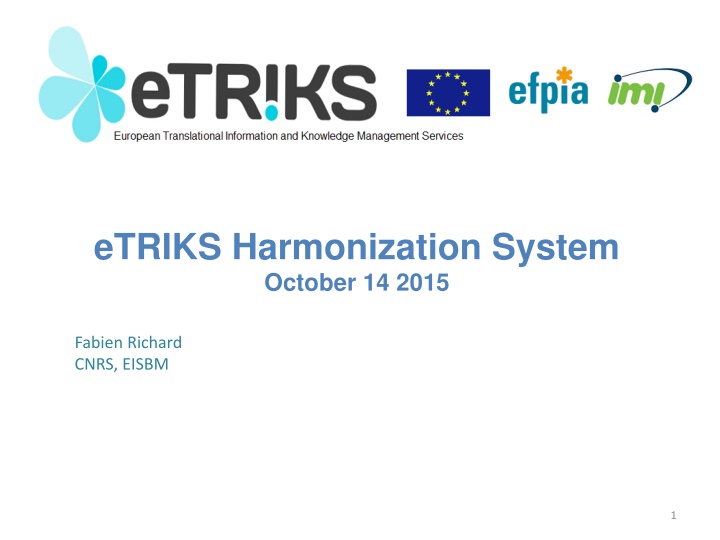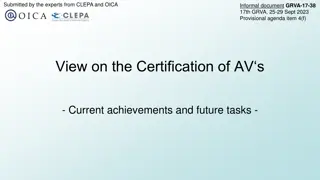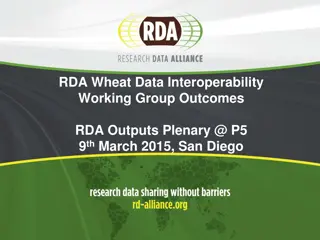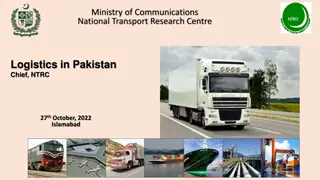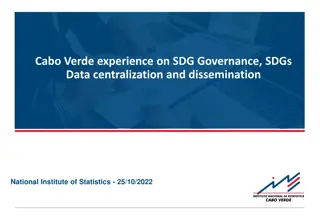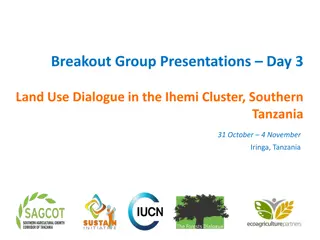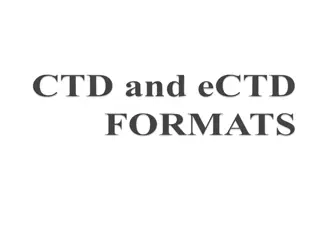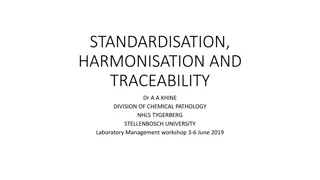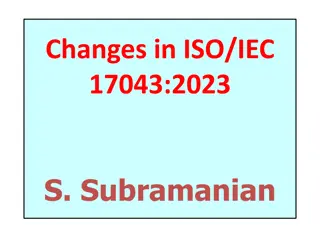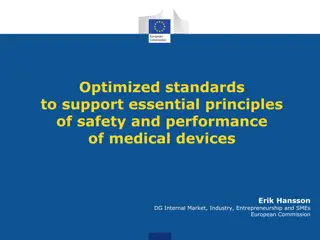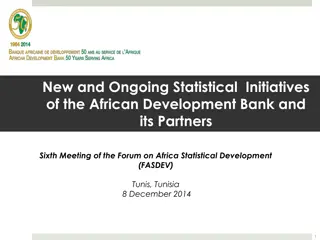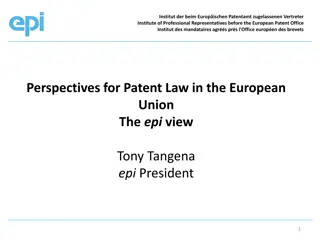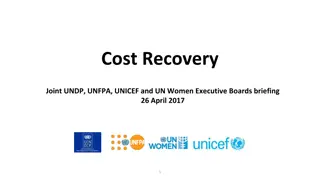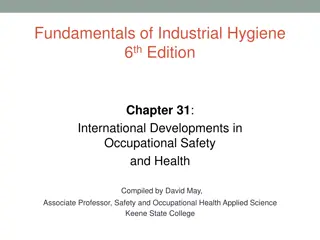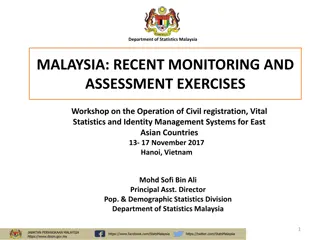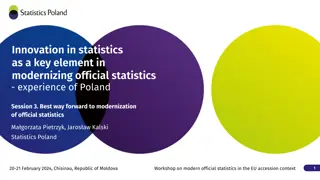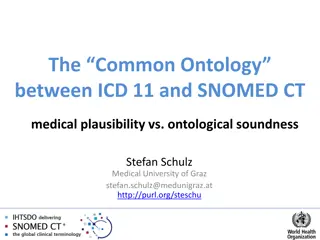eTRIKS Harmonization System
Enable data harmonization across projects through standardized terminologies, user annotations, and reporting information. Learn the importance of harmonizing data and the mission of eTRIKS Harmonization System in achieving advanced findings and personalized treatments.
Download Presentation

Please find below an Image/Link to download the presentation.
The content on the website is provided AS IS for your information and personal use only. It may not be sold, licensed, or shared on other websites without obtaining consent from the author.If you encounter any issues during the download, it is possible that the publisher has removed the file from their server.
You are allowed to download the files provided on this website for personal or commercial use, subject to the condition that they are used lawfully. All files are the property of their respective owners.
The content on the website is provided AS IS for your information and personal use only. It may not be sold, licensed, or shared on other websites without obtaining consent from the author.
E N D
Presentation Transcript
eTRIKS Harmonization System October 14 2015 Fabien Richard CNRS, EISBM 1
Presentation goals Overview of eTRIKS Harmonization System (eHS): its aims, its components, its future functionalities Key success factors Achievements and on going work 2
Why to harmonize data across projects? To increase and/or speed up: Data interoperability Cross-study analyses Advanced/integrated findings Understanding of disease mechanisms, drug targets and mode of action, patient stratification Delivering patient-tailored treatments Curation of patients 3
Mission of eTRIKS Harmonization System (1/2) Enable data harmonization across projects What does data harmonization across projects require? Data of all projects are standardized by using: The same set of terminologies, The same user s annotation information, and The same reporting information (ie MIG/template) 4
Mission of eTRIKS Harmonization System (eHS) (2/2) Enable data harmonization across projects What does data harmonization across projects imply? Two kind of repositories: Public METADATA Confidential DATA One instance Multiple instances Public terminologies Project data Annotation Information Reporting Information (Templates) 5
How to harmonize data across projects? eHS team has defined Data Harmonization Process / workflow: Harmonize study activities, assays templates, 1. Harmonize user s variables Controlled Vocabulary Term (CVT) variables, 2. Harmonize user s values CVT values. 3. Why this order? Metadata model: A template has a predefined list of CVT variables, A CVT variable has a predefined list of CVT values that come from: A public eTRIKS-selected terminology, or A eTRIKS list (if CVT values do not exist in the selected terminology). 6
Roles of eHS components in the data harmonization Several eHS components are required for data harmonization. eTRIKS Metadata Registry eTRIKS Study Design Report (eHS App.) Study trial design Study activity reports eSDR Repository of eTRIKS-selected public terminologies eTRIKS Harmonization Wizard (eHS App.) Load and transform user s data into harmonized data (based on user s annotations) Terminology Server eHW eTRIKS Post-Loading Curation tool (eHS App.) Curator s validation or correction of the user s data annotations ePLC Repository of curation policies and user annotations to CV terms Curation Base eTRIKS Data Visualization and Export (eHS App.) Visualize data, select data subset, export it eDVE eTRIKS TranSMART Integration Structure data according to the TM master tree eTI Repository of templates Template Base Biospeak DB Record data obtained or produced by the eHS App. : user s data, harmonized data, study activities and design PROJECT DATA Biospeak DB PUBLIC METADATA 7
Services between the eHS components along with the data harmonization workflow Study activities 1 5 User s data and terms Proposed templates eTRIKS Metadata Registry 7 3 Proposed CV terms eSDR + AI 8 Selection/ Annotations of CV terms eHW + AI Terminology Server 6 Selection/ Annotations of templates Queries of Harmonized data Queries of CV terms Validated new CV terms 4 2 Queries of templates Biospeak DB Curation Base 11 Validated or corrected user s annotations 12 Queries of user s annotations 12 Validated annotations 13 9 ePLC Template Base TM Master Tree schema 15 Selected data subset Validated new templates or template annotations eDVE 12 16 Visualization of user s annotations harmonized data eTI 10 14 TM-formatted Visualization of harmonized data PROJECT DATA PUBLIC METADATA 17 Load into TM Legend 18 1 Data harmonization workflow steps 8 User s inputs eHS inputs eHS actions
Interdependency between the eHS components Implications: All eHS components are needed for data harmonization across projects Coordination of the eHS component development Alignment between the data back-ends and inputs/requests of the applications/ front-ends eTRIKS Metadata Registry 5 1 eSDR eHW + AI 8 Terminology Server 6 4 2 Biospeak DB Curation Base 12 11 12 9 13 15 ePLC Template Base 12 eDVE 15 16 eTI 15 18 PROJECT DATA PUBLIC METADATA 9
How to make eHS a long-term success? (1/3) Same approach as tranSMART: Make the eHS to be adopted by the broadest community of users. Who are the users? Data providers (scientists and clinicians). 95 % of the users Data managers and curators. 5 % of the users eHS main target is users who are not experts in data management and curation. Consequence on the eHS application development: User interfaces must be intuitive (no need to read a manual) User interfaces must guide the users from what users know (eg their assays, studies, terms) toward what is needed for data harmonization (eg template, CV terms, terminologies) 10
How to make eHS a long-term success? (2/3) Other key success factors: Open-source code of the eHS components, A reference eMDR where curation knowledge, terminologies, template are publicly shared, and Standard and easy installation of Biospeak (eg docker). 11
How to make eHS a long-term success? (3/3) The higher is the eHS adoption by users: The higher adoption of good practices of data curation and reporting is, The more curation knowledge is captured in eMDR, The quicker/more automatic data harmonization is, The more time the curators have to resolve difficult cases of data curation, The higher the eHS sustainability is (raise of the developer s community). 12
Achievements and on going progresses Achievements: Definition of data harmonization process, Definition of the eHS components, Definition of services between the eHS components, Evaluation of the existing tools for the development of eMDR, Implementation of the matching algorithms for the Artificial Intelligence engine, Data model for molecular data in the Biospeak DB. On going progress: eHS application eHW, Tests of for Artificial Intelligence engine, Design of tranSMART Master Tree, Deployment of terminology service in eTRIKS (eTRIKS Lab), Deployment of eHS sandbox in eTRIKS (eTRIKS Lab), Development plan for eMDR and the curation features of the eHS applications. 13
Goals of the eHS workshop Understand the on going work, Understand the dependencies and needs of eHS components under development, Adjust and coordinate the development of the eHS components Identify the gaps (what has not been addressed yet), Define priorities of future work and timelines, Adjust the road map. 14
The eHS team Adriano Barbosa Da Silva Maria Biryukov Francisco Bonachela Capdevilla Dorina Bratfalean Ibrahim Emam Wei Gu Fabien Richard Philippe Rocca-Serra Martin Romacker Venkata Satagopam 15
